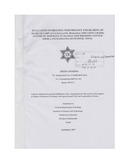Please use this identifier to cite or link to this item:
https://elibrary.tucl.edu.np/handle/123456789/1460| Title: | Evaluation of Breeding Performance and Rearing of Bighead Carp, Using LH. Rha Synthetic Hormone in Mandal Fish Breeding Center Pathaudanda, Rupendehi, Nepal |
| Authors: | Sharma, Deepa |
| Keywords: | Evaluation;Breeding;Performance |
| Issue Date: | 2019 |
| Publisher: | Central Department of Zoology |
| Abstract: | The most significant advancement in the field of aquaculture during recent decade is the development of techniques to induce reproduction in fishes. Induced spawning is essential for species which do not breed in captivity. The process of fish breeding artificially is called induced breeding. Induced breeding is a technique where organism is stimulated by particular hormones or other synthetic agents. Hormone used in induced breeding is called synthetic agents. The present study was undertaken to evaluate the breeding performance and rearing of Bighead carp (Aristichthys nobilis, Richardson 1845) using LH-RHa synthetic hormone. During this experiment, Fecundity, Gonado Somatic Index (GSI), Fertility rate (%), Hatching rate (%), embryonic development and Growth rate of fingerlings of Bighead carp was studied. Experimented fish specimens were successfully spawned by administrating LH-RHa in two doses. Initial dose of 1.5ml/kg BW and final dose of 3ml/kg BW was given to experimented female brooders fish in the time interval of 11hrs. Male was injected by single dose of 3ml/kg BW at the second injection time of female. Ovulation usually occurs about 911hrs after the second injection. During the study period the range of water temperature in different ponds was 25-38 0 C, pH of water showed it to be alkaline during whole study period i.e. 7.5-10, DO were recorded 5-9, CO2 were recorded 13.5-16. In this experiment relative fecundity of 64800-132900 in female fish of Bighead carp and GSI 8.64-9.73% was recorded. Fertility rate and hatching rate 61.5% and 52.15% respectively was recorded in experimented fish. The development of embryo was noted and studied. The development of embryo continued and hatching takes place after 12-14hrs of fertilization. Hatchlings after transferring to nursery pond, the fry were fed with artificially formulated feed with 40-45% protein regularly. The length and weight of hatchings were recorded gradually increased. |
| URI: | http://elibrary.tucl.edu.np/handle/123456789/1460 |
| Appears in Collections: | Zoology |
Files in This Item:
| File | Description | Size | Format | |
|---|---|---|---|---|
| CD final thesis Zoology.pdf | 3.75 MB | Adobe PDF |  View/Open |
Items in DSpace are protected by copyright, with all rights reserved, unless otherwise indicated.
